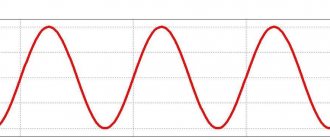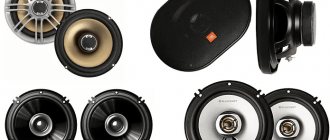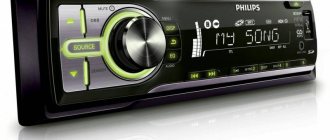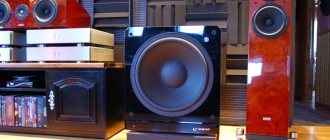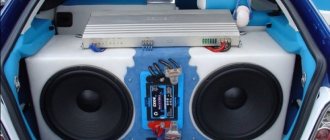Fps up » Sound » You are here
Stereo systems can be confusing, but it's not that difficult
Published 11.11.2019, 20:11 · Comments:15
You don't have to be an audiophile to have a great hi-fi home audio system. Let's take a look at what you need to enjoy a listening experience that goes beyond a smartphone with headphones, Bluetooth, or another type of wireless speaker.
What do you need for a home stereo system?
A home stereo system can be pre-packaged or assembled from individual components, with the following basic characteristics:
- Stereo amplifier or receiver : Serves as a "hub" for connecting and controlling content sources and speakers.
- Speakers : A stereo system requires two speakers, one for the left channel and one for the right.
- Source(s) : Sources provide access to music content. For systems with a built-in amplifier, the sources are external and must be connected. If the system has a receiver, it will have a built-in tuner and, in some cases, Bluetooth or internet streaming, but other sources must be connected,
Pre-assembled stereo systems
If you're a casual listener, have a small room or a limited budget, a compact (aka mini/micro) system may be the right choice as it provides everything you need (amp/tuner/receiver, speakers) to start listening to music.
Additional features may also include a built-in CD player and/or additional inputs for connecting one or more external sources.
Bluetooth also has its place. This allows you to wirelessly stream music from your smartphone to the system.
However, one of the disadvantages of this type of system is that it may not have enough power or good enough speakers to provide high-quality sound in a large room.
Location options
Installation of speakers is possible in three options:
- floor;
- wall;
- ceiling
It is important not to place them close to the surface of the walls, so as not to lose sound quality. For more financially free users looking for maximum sensations, there are systems 7.1, 9.1 and even 9.2. Their cost is much higher, which cannot always be said about the quality.
Today it has become fashionable to use ceiling speaker systems: they are installed in recreation rooms where they listen to music or have a home theater. They can be of the built-in type. The classic style arrangement is still relevant: front, rear and central. This is purely personal preference.
Important! Ceiling-type speakers are fixed only to a very strong base made of metal profiles or wooden beams.
Before making the final choice, make sure that the advantages of the ceiling speakers and that their appearance will ideally suit the interior of the room. After all the comparisons, feel free to purchase the selected option. Ceiling devices fill the entire room with uniform sound, and those present can feel like they are in a concert hall or cinema.
A caveat: when positioned, the rear speakers are a little closer to the audience than the others, so you need to use the receiver settings to equalize the virtual distance to get the ideal sound.
Build your own audio system
You can build a system using a separate receiver or a built-in amplifier, speakers and source devices. This type of system allows flexibility for your preferences and budget, as you can choose the components and speakers you want.
However, this increased flexibility may cause your system to take up more space than pre-built hardware, as well as increase your setup and upgrade costs.
Basic characteristics of a stereo receiver
- Amplifier : Supports two-channel (stereo) speaker setup.
- AM and/or FM tuner : for listening to local radio stations.
- Analog Audio Inputs : For connecting compatible source devices.
Additional parameters for connecting a stereo receiver
- Phono Input : Included in most stereo receivers for connecting a turntable.
- Digital Audio Connections: Digital optical/coaxial audio inputs can be provided to access audio from some CD players and most DVD/Blu-ray players, cable/satellite boxes, and televisions.
- A/B Speaker Connection : Allows you to connect four speakers, but surround listening is not supported. Speakers "B" mirror the main speakers and draw power from the same amplifiers. Half the power goes to each pair of speakers. The A/B speaker option allows you to listen to the same sound source in a second room or provides greater coverage in a larger room.
- Zone 2 : Some stereo receivers have a Zone 2 output, which sends a stereo signal to a second location, but requires external amplifiers. Zone 2 allows you to play different audio sources in the primary and secondary locations.
- Subwoofer Output : Select a stereo receiver that allows you to connect a subwoofer.
A stereo system with a subwoofer is called a 2.1-channel setup.
- Wireless multiroom audio. Some stereo receivers include platforms such as MusicCast (Yamaha), DTS Play-Fi, and Sonos (Onkyo/Integra) that allow you to send music wirelessly to compatible speakers.
- Ethernet/Wi-Fi: Ethernet and/or Wi-Fi can be enabled to access music streaming services and/or network-attached audio storage devices.
- Bluetooth : When enabled, allows you to stream music from compatible smartphones/tablets.
- USB : If a USB port is provided, allows you to listen to music from flash drives and/or portable hard drives.
- Video connections : Some receivers have video connections. These can be analog (composite) or HDMI, which provide only signal transmission. Stereo receivers do not perform video processing or scaling.
Speaker types and placement
Speakers come in different types and sizes, and their placement is important. If you have limited space, bookshelf speakers may be better, but for larger rooms it's worth sticking with floor-standing speakers, especially if the receiver doesn't have a subwoofer output.
It is best to place the speakers about 6-8 feet away (about 3-4 feet from the center of the front wall) or in the front corner. However, do not place the speakers on a wall or in a corner. There needs to be space between the speaker and the wall/corner.
The speakers should not be pointed straight ahead, but should be aimed at right angles to the listening position (the "sweet spot"), providing the best balance of sound direction.
Source options for audio only
Some audio sources you can connect to your stereo receiver or amplifier include:
- Turntable : Possibility to connect Phono to ground or analogue line.
If the player includes a USB output, it is designed for connection to a PC and is supported by additional software.
- CD Player : CD players provide analog audio connections, but some provide analog and digital optical and/or coaxial audio connections.
- Cassette deck: An audio cassette can be connected to a stereo receiver via analog audio connections.
- TV : If your TV has an audio output, you can connect it to a stereo receiver to play audio from the TV.
- Network Audio Player : Network Audio Player can access music from select streaming services and music stored on PCs or media servers. Bluetooth and USB can also be included. This is practical for receivers that do not have these features. Analog and digital audio connections are provided.
- Media Server : If the stereo receiver has a network connection, it can play music from a media server (NAS, PC) without connecting to an external network audio player.
Audio/video source parameters
A stereo receiver with analog or HDMI pass-through allows you to connect video sources such as:
- DVD/Blu-Ray/Ultra HD players
- Media streamers (Roku, Chromecast, Fire TV, Apple TV)
- Cable/Satellite Boxes
- VCRs
Make sure any video connections on your stereo receiver are compatible with your source's video connections.
Stereo or surround sound?
Some people have a stereo music system and a separate surround sound system for watching TV/movies.
However, home theater receivers can also be used to listen to stereo music, since almost all of them have a two-channel (stereo) listening mode. This "mutes" all speakers except the front left and right speakers.
Home theater receivers can also process stereo signals for distribution across five or more channels via Dolby ProLogic II, IIx, DTS Neo:6 or other audio processing. This provides a more immersive music listening experience, but changes the character of the original music mix.
Acoustics for home cinema
When choosing acoustics for your home, it is important to decide what functions the purchased system will have. The demands of modern people vary, and if clear sound is important for sophisticated music lovers, then for an ordinary housewife rattling pots and pans, volume will be the key parameter. At the same time, it is worth soberly assessing the parameters of the room, because “squeezing” concert equipment into a closet is not entirely reasonable. It is also important to pay attention to the brand under whose auspices the speaker system was manufactured. And believe me, there are plenty to choose from. But even despite this, BBK acoustics are in particular demand among music lovers, housewives and lovers of good sound!
Number of acoustic bands
Home acoustics can be either one- or five-way. Having no special requirements for sound or being the proud owner of an ear that was stepped on by a bear, you can be content with one band, where all the music will be reproduced by one speaker. The best option would be two-way systems, in which the left speaker is responsible for the lows and mids, and the right one is responsible for the high frequencies. Three-way systems will be a delight for the ears of more demanding music lovers, because all frequencies are reproduced by separate speakers!
Power is not volume!
There is a myth among buyers looking for acoustics for home use that equalizes the power and volume of audio systems. In reality, everything is completely different: a loud sound will certainly wake up the neighbors, but will in no way be an indicator of power. The strength and power of acoustics lies in its mechanical reliability. Also, you should choose a system based on the characteristics of the speakers themselves: the power of the amplifier should not exceed the same figure in the speakers. Otherwise, as the famous proverb says, “the music didn’t play for long...”
Frequency range and system sensitivity
The real indicator of a system's volume level is its sensitivity, measured in decibels. The higher this indicator, the stronger the sound from the speakers will put pressure on the surroundings. In other words, the higher it is, the louder the sound, and therefore more powerful. For the ears of an ordinary music lover, 85 dB is a pretty good indicator.
An equally important parameter when choosing home acoustics is frequency. Human hearing allows you to hear sounds in the range from 20 to 20,000 hertz. Low sounds include sounds up to 150, medium ones sound at 100 - 7,000, while sounds in the range from 5,000 to 20,000 Hz are considered high. If you purchase acoustics as an add-on, 100-20,000 Hertz is sufficient. The most sophisticated music lover should opt for systems with a frequency of 20-35,000 Hertz.
Standard passive or professional active?
A distinctive feature of the active system is the fact that each of the speakers has its own amplifier. Filters are installed at the input, and their activity creates a lot of advantages: they boast wide variability and the ability to fine-tune. The presence of amplifiers provides improved playback quality. Active systems are capable of operating in an extended frequency range, and also have a volume control on each speaker, which in itself is an undeniable operational advantage. In turn, passive systems are simple: there is no need to supply a signal and voltage to each speaker, because this is already provided by the manufacturer. The most important disadvantage of such systems is the need to use a remote amplifier.
Housing types
Among all the options presented on the modern market, closed-type and bass-reflex systems are in particular demand. Closed-type cases are the easiest to produce, and the flight of thought of modern designers allows the most daring ideas to be realized! But it is important to remember that in a closed box vibrations are most noticeable, which ultimately has a rather unpleasant effect when reproducing low frequencies. That is why the housings of really serious installations are made of the bass reflex type.
PVC, chipboard or wood?
Each of the presented materials has a number of its own advantages: plastic, due to its pliability, provides a stylish design and excellent ergonomics, but greatly distorts the sound when the volume is increased (the noticeable rattling of speakers is familiar to every owner of plastic speakers). Due to this fact, such acoustics are ideal for sounding computers, while for home use it is more preferable to buy speakers with a wooden case. But if you buy PVC speakers, it is important to remember that the irregular shape, the lack of wide panels, and the lack of ventilation surfaces are signs of a truly high-quality product!
All at once or in parts?
Almost all home acoustics on the market come complete. But often, serious brands also sell individual parts of systems. Often, the finished kit includes a central unit, side speakers and a subwoofer. You can also purchase side speakers, rear speakers and additional speakers to create the effect of full presence.
When choosing a standard set, it is important to take into account the number of speakers: the front and rear are paired, and the subwoofer and center must be equipped with their own speakers. When assembling acoustics yourself, in addition to the DC system, it is worth including the rear channel, which provides a completely immersive effect.
In addition, based on the type of attachment to the surface, speakers and subwoofers are divided into ceiling-mounted and floor-mounted. This information is important for those who want to assemble their system in parts: floor-standing speakers have increased power and sound volume, while ceiling-mounted options will help save room space, which is especially important for residents of cramped apartments in big cities.
Home acoustics included in the home theater system are equipped with:
- Front speakers
The speakers, installed on the sides of the listener, do most of the work when playing material. The class of the front speakers allows you to assess the class of the entire system. It is not surprising that special attention has to be paid to their choice. It is important to consider that for full operation all systems (front, rear and center channel with subwoofer) must work in absolute harmony, therefore it is not recommended to buy speakers from different brands.
Front speakers show maximum efficiency when reproducing mid and high frequencies. The subwoofer is responsible for low-frequency effects. In other words, the deeper the low-frequency soundtrack of a film, the lower the quality of sound reproduction on the front speakers.
- Central channel
To play human speech (without dubbing), the central channel speaker system is used. In addition, the center channel works with music and individual sound effects (Wide), partially taking over the functions of the front speakers. In an ideally selected configuration, the central control, left and right speakers should be identical.
Placed in line with the TV. The most optimal installation location is a niche under the screen. Also, small acoustics can also play the role of the central speaker, and low frequency compensation is transferred to the front speakers (in Normal mode). When the Plantom mode is turned on, the presence of a central speaker is simulated for the listener, who is located exactly in the center of the entire system.
Magnetic shielding of the center channel acoustics will eliminate screen distortion. Also, high-quality speaker technology has taken measures to protect against third-party noise vibrations that can spoil the viewing experience.
- Rear speakers
Rear acoustics provide a surround sound effect. Often, there are no special requirements for such speakers, so any speakers that can be installed at a height above the viewer’s ear can be used as rear acoustics. It is recommended to match the sound of the rear and front speakers, but since minor differences are allowed, this matter can be skipped. However, simplicity does not mean that you can approach the purchase “carelessly.” Five-channel formats (DTS, Dolby Digital) work in several ranges at once, so incorrectly selected rears will not allow you to feel the full effect!
Rear acoustics are divided into directional and dipole. Directional ones are used in modern DTS and Dolby extensions, as well as when playing multi-channel music in DVD audio format. They are especially effective when playing tracks in studio quality. When placed correctly, directional speakers can create an immersive experience by bringing sound effects to the rear of the viewer.
Dipole rear speakers emit vibrations of different phases from two speakers at once and are used for Surround and Pro Logic from Dolby. The rear speakers provide slightly blurred background sound, and their location is not significant.
It is preferable to buy rear speakers complete with the rest of the system components. Otherwise, it is recommended to select rear speakers for a front pair or triple based on the brand or similar characteristics of the speakers.
- Subwoofer
It is used as a separate component responsible for reproducing “deep” sound effects. It plays an important role in organizing high-quality sound, especially in home theaters, adding additional expression, dynamics and drama to the already driving sound. Also, the subwoofer prevents overloading the speakers, reducing the intensity of distortion. This type of speaker system can be divided into subwoofers that require connection to an amplifier (passive), as well as subwoofers that are completely independent of an external source (active).
The subwoofer housing can be made in a bass-reflex, closed or narrow-band version, protecting the “filling” from excessive vibrations. Often, its dimensions are quite large, and the design can spoil the entire impression of the interior. But taking into account the fact that a person with his own hearing is unlikely to catch the exact movement of low sound, you can get by with one subwoofer, which can be placed almost anywhere.
5.1 systems are suitable for home use: 5 speakers and 1 subwoofer. It is worth noting that systems 6.1-9.1 are currently on the market. For example, 6.1 is an expanded version of the traditional system, complemented by a rear center channel, while 7.1 adds two side speakers. At the moment, due to the rarity of films with 7.1 sound in our country, the 5.1 format is in high demand.
Important information when choosing a system
Before you look into your wallet, consider the following:
- Critical or Casual Listening : Whether you're a critical or casual listener, try a demo of the system or components you're considering. If it doesn't sound good in front of the seller, it won't sound good at home.
- Small or large room : If you have a small room, a compact system may be suitable. If you have a large room, make sure your choice can fill the room with pleasant sound.
- Music vs. TV/Movie Listening : If you want to use a stereo system for TV and movie sound in addition to listening to music, consider a system that allows you to connect a subwoofer and provides pass-through connections for video.
If you're primarily a TV/movie watcher and only listen to music casually, consider a soundbar or home theater receiver and a set of surround speakers.
How to choose the right speaker system for your home
Before purchasing an acoustic set, you should decide for what purpose the purchase is being made, in which room the equipment will be placed and the desired sound quality. After which the desired price category is set, since the cost of audio equipment fluctuates greatly. When choosing equipment, pay attention to the following selection criteria.
Acoustics
One of the main indicators of the system – acoustics – will depend on the choice of speakers. For guidance in choosing speakers, special markings have been adopted. The system with characteristic 1.0 is represented by two portable speakers. The sound is the simplest. AC 2.0 already has two front speakers that provide stereo sound. They are quite enough just to listen to music or watch a movie. The AC has 2.1. There is already a subwoofer that adds high-quality bass. If you install it on the floor and the satellites on the table, you can watch a movie with high-quality sound. However, this option is not recommended for listening to music because the low frequencies are too active. For listening to music in good quality, a 4.0 system with two front and two rear speakers is more suitable. It will also be suitable for cinema. AC 4.1 is complemented by a subwoofer, and 5.1. It has a central speaker, two front and two rear, plus a subwoofer. The latter system guarantees excellent transmission of special effects.
Power
For home use, an AC power of 25-40 W is sufficient; for a large room, you can purchase a more powerful system, up to 150 W,
Frequency range
If equipment is purchased primarily for watching movies or computer games, then you should pay attention to speakers that can transmit low frequencies - from 10 Hz. For music lovers, it is preferable to purchase speakers with a frequency capability of up to 40 thousand Hz.
Equipment material
Wood conveys sound best. The highest quality speakers are made from MDF, less preferably from chipboard; the aluminum body ensures good safety of the equipment, but the sound in it is distorted. Plastic is not durable.
Stereo system cost and performance
Balance what you want with your budget. You don't have to buy a high-quality stereo receiver, but make sure the one you buy has all the features and connectivity options you need or plan to use in the future. Stereo receivers start at $120 and go up to $1000. Also keep these tips in mind:
- Don't be tempted by the amplifier's power output specifications.
- You don't have to spend a fortune on cables and wires. Beware of 6-foot speaker wire, which costs $100 or more.
- Don't expect a $2,000 pair of speakers to sound twice as good as a $1,000 pair of speakers. As prices rise, there is often only a gradual increase in quality. There are great expensive speakers, but there are also moderately priced speakers that provide great performance for the price.
Nuances of power
When acoustics are made on the basis of passive sound radiators that do not contain built-in amplifiers, then their power is considered by experts to be nominal. Manufacturers indicate Root Mean Square - the root mean square power of the speaker amplifier at which it can operate for as long as desired.
There is Peak Music Power Output - peak musical output power that any acoustics can withstand only for a short time, no more than a second. The main criterion when choosing the power of equipment is the size of the room where it will be installed:
- with an area of 17 sq. m. 60-80 W will be enough;
- if the room is 20-30 sq. m., then focus on 100 W;
- with large, spacious living rooms of more than 40 sq. m., you will need 150-200 W.
All the above calculations are given under the condition of using mono-channel acoustics. When making the final choice of a home theater system, two main parameters must be taken into account: the power of the installation and its sound quality. They have a significant impact on the overall price, but the volume and sound pressure will depend on the power.
Expert advice! In a home theater set, all devices have the same sound parameters. If you select speakers yourself, there may be various discrepancies in the sound range.
For a small room where no more than two people will watch movies, it is quite enough to purchase a system with compact ceiling-type speakers, which is considered by experts to be a more acceptable option when located in limited spaces.

